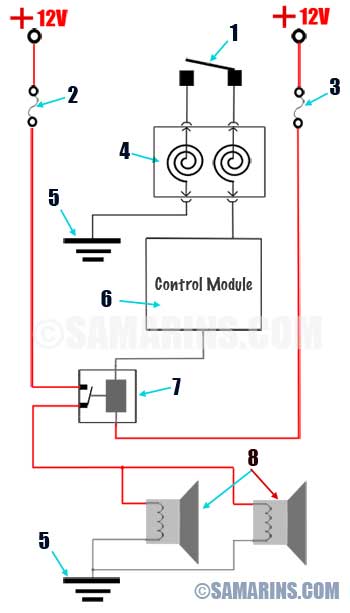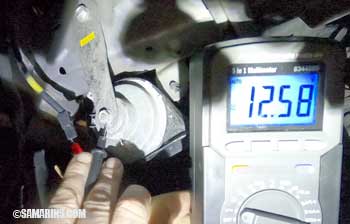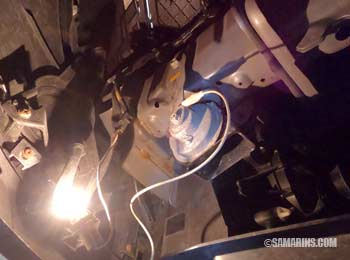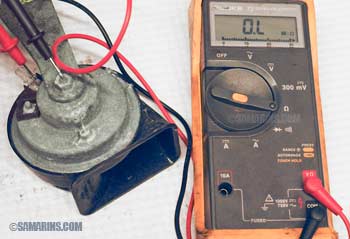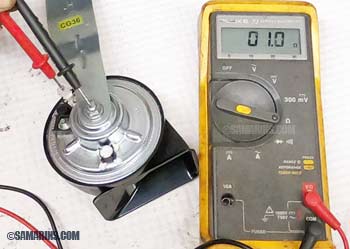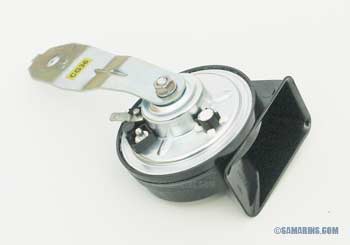Horn in a car: How it works, problems, testing, diagram
Updated: October 25, 2019
The horn in a car is a safety device. If it doesn't work, the vehicle is deemed unsafe to drive. Problems with the horn in a car not working at all or sounding distorted are common. However, the electric circuit that controls the horn is fairly simple, and in most cases is easy to diagnose, see the generic electric horn circuit diagram:1. Horn switch in the steering wheel.
2. Horn fuse.
3. Horn relay fuse.
4. Clock spring assembly.
5. Ground connections.
6. Body Control Module (BCM).
7. Horn relay.
8. Low and High Horns.
How do mechanics diagnose the horn that doesn't work? The first easy step is to check whether the horn relay clicks when pressing the horn. The horn relay is located in one of the fuse boxes, typically the one under the hood. You can identify the horn relay by looking at the diagram on the inside of the fuse box cover or the diagram in the owner's manual.
If the relay clicks (you can hear audible clicking), it means that the problem is downstream from the horn relay (see the diagram).
We created this generic diagram to illustrate; you need to check the diagram for your particular vehicle, which might be different. If you cannot find the diagram for your car on the internet, we posted a list of websites that offer paid access to service manuals of different cars at the bottom of this article.
The next step is to check the voltage at the horn when pressing the horn on the steering wheel.
| While pressing the horn inside the car, we measured the voltage between the horn connector and the ground. As you can see it's 12.58 Volts, so there is power, but the horn is quiet. It means the horn is bad. |
| Mechanics often use a different method to check for 12 Volt power: The 12 Volt bulb is connected instead of the horn. Press the horn and see if it lights up. This method is helpful when you don't have an assistant. As you can see, the bulb lights up when pressing the horn, but the horn was quiet, which means it's the horn that is bad. Of course, the horn wire connector must be checked for damage or corrosion, which is quite common. If the horn relay clicks but there is no voltage at the horn connector, the wiring between the relay and the horn must be checked for continuity. |
| Another way to check the horn is to measure its resistance. Normally the resistance should be low, within a few Ohms. This is the same horn from the tests above. As you can see, the resistance shows O.L or open loop, in other words, the horn has no continuity. |
| We tested the resistance of the new horn and it shows 1 Ohm, as you can see. |
What if the horn relay doesn't click when pressing the horn? This means the problem is upstream from the horn relay, again, check the diagram. The next step in this case is to check the fuse for the horn. Read also: How to check fuses.
If the fuses are OK, the clock spring, horn switch and the wiring should be tested. which is a bit more difficult and should be done in accordance with the testing procedure and the wiring diagram for your vehicle.
From our experience the next common part that can cause the horn not to work is the part called "clock spring", which is a spiral cable in the steering column. One of the symptoms of a possibly bad clock spring is when the airbag light came ON at the same time the horn stopped working. Often, other switches (e.g. cruise control) located on the steering wheel may not work too. Read more about the clock spring.
Horn Replacement: In most cars the horns are easy to replace. They are often located behind the grille or behind the front bumper in front of one of the wheels. We recommend using OEM horns or aftermarket horns that are designed to fit your car without altering the wiring. Your auto repair shop may charge 0.3-0.8 hours to replace the horns (not including diagnostics) plus the part, which is usually within $100. If you want to replace the horn yourself, YouTube has plenty of how-to videos; search for your vehicle's year, make, and model.
Read Next:
Pros and cons of turbo engines.
Starting system, starter motor: problems, How the starting system is tested
Timing belt: when should it be replaced, what happens if it breaks
Serpentine belt, tensioner: problems, signs of wear, when to replace, noises
Check Engine light: what to check, common problems, repair options
Pros and cons of turbo engines.
Starting system, starter motor: problems, How the starting system is tested
Timing belt: when should it be replaced, what happens if it breaks
Serpentine belt, tensioner: problems, signs of wear, when to replace, noises
Check Engine light: what to check, common problems, repair options
